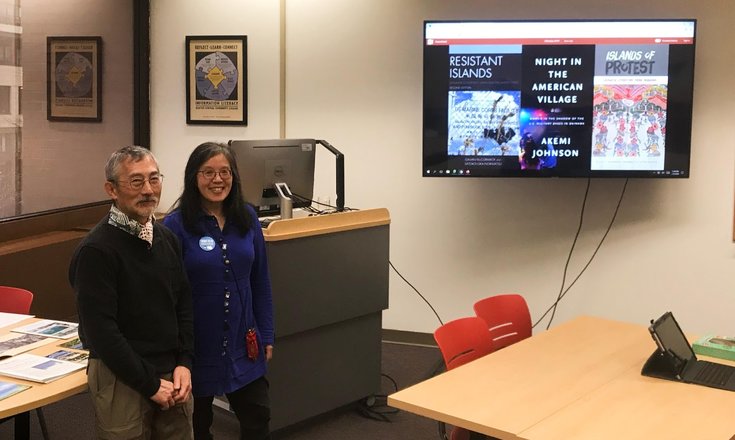It was January 23rd as the clock turned 11:46 A.M. that a young woman darted around Seattle Central Library’s Room A, meticulously arranging the lecturn area. Kimberly Malone, the COSI (Conversations on Social Issues) coordinator, had prepared everything just so, 14 minutes ahead of schedule for the Peace and Labor Activists in Okinawa talk. At 11:58 A.M., the office decor fell quickly to the background when history professor and activist Tracy Lai stepped up to the podium, accompanied by fellow Asian Pacific American Labor Alliance delegate Stan Shikuma. A dark gradient framed the scenery outdoors with a sense of eerie apropos on the bleak January afternoon.
The presentation began with a chilling photo of what could have been a scene from a Stephen King novel. Visions of war and gunfire came to life just to the right of the two presenters.
It’s important to note that Lai and Shikuma both prefaced this with a notice and apology for potentially triggering content. “We need you to know what happened during that battle,” Lai explained. The battle in question was the Battle of Okinawa, a conflict during WW2 that claimed more than half of the island’s 400,000-person population. Many of those not killed were rounded up by U.S. Marines and placed into concentration camps, Lai and Shikuma explained.
While annexation of Okinawa by the Japanese government had taken place in 1879, the sentiments engendered still felt raw to many of Okinawa’s residents 60 years later. As Shikuma and Lai put it, Okinawa, a nation with its own culture, language, and politics was forcibly and abruptly assimilated. Children were punished for not speaking Japanese. They were punished for not using their Japanese names. What once was an independent trade hub between Korea, China, and Japan was now exclusive property of the latter. Naturally, “resettlement” by the U.S. government, to put it mildly, brought back some not-so-fond memories.
Shikuma, whose family had been among those to face incarceration in these camps, spoke at length here. Erected on the landing site used by the U.S. Marines during the battle, Okinawa Peace Memorial Park stands as a memorial for the more than 200,000 people who died during the three-month battle. There are no ranks, only names organized alphabetically; the park stands as a harrowing reminder of why the Okinawan Peace Movement, a social movement that actively opposes the building of new military structures on the island, exists.
In the words of Shikuma and Lai, Okinawa hosts 70% of all Japanese U.S. bases, with another under construction. Considering Okinawa’s strategic position, there’s little mystery as to why it’s been historically given so much attention. There’s also little mystery as to what would happen to an island the size of Okinawa were it to become a target as a result of such a concentrated military presence, Lai stated. Quite simply, “We remember, we know. We’ve been through this destruction already.” This destruction, as Lai had mentioned previously, took place on an island roughly as large as the distance between Tacoma and Everett.
But the presence of the U.S. military hasn’t been all bad. Soldiers missed their dairy, Lai explained in an ironically lighthearted turn. The ice cream chain Blue Seal, which served unique local and American flavors, saw its inception on one such military base in 1948.
Unfortunately, the more indirect effects don’t present themselves in such a welcoming, genial way as an ice cream parlor might. As the talk began to wrap up, Lai and Shikuma spoke of a school which borders a U.S. airbase. The airbase features several neatly aligned rows of Boeing MV-22 Ospreys, VTOL (vertical takeoff and landing) multimission aircrafts capable of both acting as a helicopter and conventional plane. When given the signal, children at Futenma Elementary know to rush into a bunker built to withstand the forces generated by falling aircraft debris. Several accidents have prompted public motions to relocate the base.
Henoko and Oura Bay is to serve as the relocation site of Futenma Air Base, and is likely a soon-to-be former haven of more than 5,000 species of coral along with a population of endangered dugong. The Bay is being actively overhauled for a landing strip, as it’s an area uniquely unsuitable to support the landing of heavy aircraft. A questionable endeavor to fortify the Bay with 50,000 pillars means that reclamation would be almost impossible. Lai and Shikuma argue: What, then, is the sensible choice? For Okinawa to be left alone.
As the clock hit 12:46 P.M., Lai made one request of the audience. Adam Smith, the chairman of the Armed Services Committee, is required to document any communication made to him by a Washington resident as a matter of public record. So, to “students, faculty, anyone” who feels that Okinawan citizens live in a large enough military hotspot, Lai says to send Smith a message. Let him know that you don’t want to see yet another base. Let him know that children shouldn’t have to flee underground to avoid being crushed to death by pieces of flying aircraft. Let him know that the idea of irreparably destroying an aquatic habitat for a species on the IUCN’s critically endangered list is repulsive. Let him know enough is enough.
Chairman of the Armed Services Commitee, Adam Smith, can be contacted here.







Be First to Comment